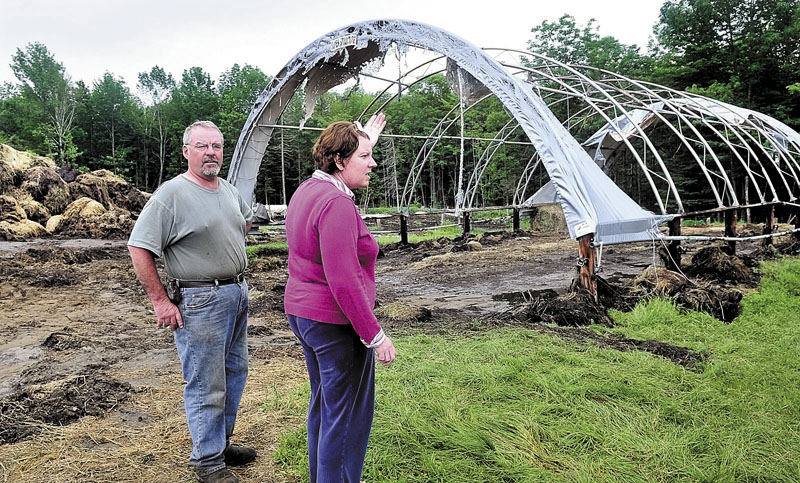STRONG — It’s a farmer’s nightmare: losing all your cattle’s winter feed.
Between 250 and 300 large, round hay bales were destroyed by fire when they spontaneously combusted early Sunday at River Run Farm, located on South Strong Road.
In total, the bales were worth between $10,000 and $12,000, said Rupert Pratt, who runs the farm with his wife, Sue. They had planned to feed the hay to their 40 Beef Shorthorns and four Southdown sheep this winter.
“I’m thankful it’s not near the house,” Sue Pratt said. “You have to count your blessings.”
About 40 firefighters from six towns responded to the blaze around 1:40 a.m., said Duayne Boyd, chief of the Strong Fire Department.
It took hours for responders to douse the flames because they had to remove each bale with an excavator, he said. They then had to spread out the hay to make sure it wasn’t still smoldering inside.
Each bale was the size of about 16 regular square bales, Rupert Pratt said. No bales could be saved.
Though the metal frame of the 30- by 60-foot portable storage building survived the blaze, the owners will need to purchase a new, heavy-duty tarp for the roof, which will likely cost more than $5,000. The structure was not insured.
The couple said they will now clean up the site, replace some wooden planks, put on a new roof and hay their other fields. They have a second crop growing in one field and a first crop to cut.
“It’s the nature of farming — resilience,” Sue Pratt said.
Firefighters from Strong, Temple, Industry, Phillips, Farmington and New Vineyard responded.
The owners were staying at nearby Porter Lake when the fire broke out. They first arrived home around 3 a.m.
The most common cause of hay fires is excessive moisture, which creates a good environment for a type of bacteria to grow.
When conditions are right, the bacteria release heat that can increase the interior temperature of a bale to more than 175 degrees, according to a report published in 2008 by John Slocombe and Lyle Lomas, of Kansas State University.
Any of the following symptoms could mean a fire is imminent: The hay has a slight caramel, musty or strong burning odor; there’s visible vapor or smoke; or the hay feels hot to the touch.
People should not move smoldering hay because it could expose it to oxygen and increase the likelihood of a fire, the report says.
Erin Rhoda — 474-9534
erhoda@centralmaine.com
Copy the Story LinkSend questions/comments to the editors.



Success. Please wait for the page to reload. If the page does not reload within 5 seconds, please refresh the page.
Enter your email and password to access comments.
Hi, to comment on stories you must . This profile is in addition to your subscription and website login.
Already have a commenting profile? .
Invalid username/password.
Please check your email to confirm and complete your registration.
Only subscribers are eligible to post comments. Please subscribe or login first for digital access. Here’s why.
Use the form below to reset your password. When you've submitted your account email, we will send an email with a reset code.